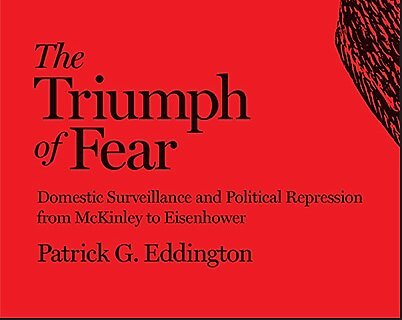A new book, The Triumph of Fear: Domestic Surveillance and Political Repression from McKinley to Eisenhower, by Cato’s Patrick G. Eddington, a senior fellow in homeland security and civil liberties, was released on April 1. The book, excerpted below, examines the rise and expansion of surveillance-enabled political repression in America from the late 1890s to early 1961 and shows how this domestic spying has helped fuel federal assaults on free speech and association that continue to this day. To purchase the book, click here, here, or here.
Conclusion
At the dawn of the twentieth century, the only two executive branch agencies routinely involved in domestic surveillance and related political repression were the Secret Service and the Postal Service, and the former—despite the relatively limited number of Secret Service agents—was far more active than the latter, which acted as a partner with the Treasury Department’s investigative arm when needed. Three related events changed that and put the United States on the path to creating a domestic surveillance and political repression apparatus that in time would rival those of its European neighbors.
The first event was the growth of the popularity of anarchist, socialist, and communist ideals among major segments of American labor and left-leaning political elites.
As noted in Chapter 1, at least as early as 1898, the Secret Service was monitoring anarchist political activists and labor organizers in places like Patterson, New Jersey, at the time a major hub of both immigrant labor and textile mills with generally deplorable working conditions. In the period between the Spanish-American War and President McKinley’s assassination, federal authorities had generally been content to keep an eye on key anarchist groups and leaders while leaving it to state and local authorities to deal with anarchist-inspired or led strikes and labor–business disputes, even when violent incidents occurred.
The second key event was McKinley’s assassination by the (likely mentally disturbed) recent anarchist convert Leon Czolgosz, which transformed the political and domestic security landscape.
Officials at the federal, state, and local levels went after known or suspected anarchists in communities across the country. During Roosevelt’s first abbreviated term as McKinley’s successor, the Secret Service intensified its surveillance of those deemed political radicals, and Congress passed the Anarchist Exclusion Act, which barred legal entry into the United States of anyone professing a belief in anarchism. Those measures failed to stamp out the appeal of anarchism, and its rival political philosophy, socialism, gained even more adherents during Roosevelt’s two terms in office.
Roosevelt’s subsequent efforts to employ the Secret Service and Postal Service against Socialist Party presidential candidate Eugene V. Debs and the socialist newspaper Appeal to Reason set additional, dangerous precedents that threatened the Bill of Rights. But it was the Roosevelt administration’s more widespread misuse of the Secret Service to engage in politically related investigations, and even prying into the marital affairs of a junior US Navy officer, that would trigger a confrontation with Congress that sparked Roosevelt’s unilateral expansion of federal domestic surveillance and the potential for widespread political repression in the decades that followed through the creation of the Bureau of Investigation.
The Navy Department’s use of a Secret Service agent to uncover Ensign Earl Pritchard’s extramarital affair in late 1907 generated a national uproar and a legislative backlash from Congress, which in April 1908 barred Secret Service agents from being used for anything other than presidential protection and capturing counterfeiters. When Roosevelt responded by instructing Attorney General Charles Bonaparte to create a cadre of investigators within the Justice Department itself, he did so despite the lack of any authorizing legislation allowing it. A precedent of presidential circumvention of a congressional ban on a surveillance activity or authority had been set, and it would be repeated by Roosevelt’s successors or their subordinates over the balance of the twentieth century.
The episode also marked one of the last times Congress would take decisive action to rein in presidential overreach on surveillance activities during the twentieth century. The decline of true, probing congressional oversight actions targeting the executive branch was the third key development that accelerated the rise and growth of the American surveillance state.
With the outbreak of World War I and America’s subsequent entry into the war in April 1917, Congress largely jettisoned its role as an overseer of executive branch actions in the areas of security policy and surveillance, instead becoming a full partner in expanding the legal framework that enabled widescale, pervasive domestic surveillance and political repression, particularly in connection with the First Amendment, free speech, and the press.
The enactment during the war of the Espionage Act, the Trading with the Enemy Act, the Food and Fuel Control Act, and the Sedition Act represented a radical expansion of federal surveillance and prosecutorial powers that harmed thousands of innocent Americans and the press while doing little, if anything, to help defeat the Central Powers. The subsequent Harding administration engaged in a limited rollback of those wartime authorities, persuading Congress to repeal the Sedition Act and Food and Fuel Control Act. But the Espionage Act and Trading with the Enemy Act were left in place, and the broad language of the former would be used decades after the Great War to prosecute intelligence community whistleblowers like Edward Snowden. While it is true that the Army and Navy intelligence bureaucracies and the FBI shrank substantially after the war, the FBI’s profile did not, largely supplanting the Secret Service as the premier domestic surveillance agency in the federal government, with the number of its field offices spreading to every state and territory well before the outbreak of World War II in Europe.
In his landmark work Crisis and Leviathan, historian Robert Higgs noted this “ratchet effect” on government power in the aftermath of a major crisis. “Without the powerful ideological and constitutional restraints that operated for over a century after the birth of the United States—restraints destroyed during the national emergencies of 1916–1945—modern governmental authorities may,” Higgs wrote, “drink deeply and often from the heady wellsprings of political power and social control.”1 In the context of domestic surveillance and political repression, this proved true time and again between 1919 and 1961.
The victory of Soviet forces in the Russian civil war had a further galvanizing effect on American political elites and the emerging national security establishment. A political and economic philosophy totally at odds with the American and western European model had captured the largest (in geographic terms) country on the planet, and the leadership of the new Union of Soviet Socialist Republics was intent on exporting their philosophy and governing model around the world. In the United States, this triggered the first Red Scare and a related push by both the Congress and executive branch law enforcement and intelligence elements to identify, expose, and where possible prosecute or deport those openly sympathetic to the Soviet cause.
In the congressional context, it would lead first to the House creating the infamous Fish Committee, then the McCormack–Dickstein Committee, and later the Select Committee on Un-American Activities—with the latter conducting unconstitutional raids on civil society organizations and even engaging in wiretapping during FDR’s presidency. Well before the end of World War II, the renamed House Committee on Un-American Activities would effectively be made permanent, going on to become among the most feared and loathed institutions in American history. During Truman’s tenure, HUAC got a Senate counterpart—the Senate Internal Security Subcommittee.
Over the course of several decades, HUAC’s and SISS’s public show trial–style hearings would destroy the professional and personal lives of thousands of Americans who had no connection to Soviet espionage efforts. Even those who would confess to having been CP USA members or had otherwise dabbled in radical politics would never be proven to be active Soviet espionage agents. Their “crime” was that they had explored, then in most cases abandoned, a political and economic philosophy that was vehemently opposed by their own government and the overwhelming majority of their fellow citizens but that never posed a realistic threat to the survival of the Republic.
The interwar period also saw the executive branch engage in vastly expanded domestic surveillance targeting of known or suspected communists, with the FBI, MID, and ONI all heavily involved in the effort. Wiretapping controversies also grabbed the spotlight, especially after the Supreme Court effectively sanctioned it via its 1928 Olmstead decision. The congressional backlash against the decision led to the 1934 passage of the Communications Act, which banned the practice outright. In the six years that followed, FDR and his senior law enforcement and intelligence officials periodically debated whether or not to seek to change the law to allow wiretapping in specific circumstances. By the late spring of 1940, FDR decided to go it alone, ignoring the most recent Supreme Court decision affirming the Communications Act’s ban on wiretapping (the Nardone case) and telling his then-Attorney General Robert Jackson in May 1940 to proceed with wiretapping in national security cases, particularly espionage. Like his late cousin and predecessor Theodore Roosevelt, FDR was comfortable circumventing Congress and the federal courts in matters involving domestic surveillance activities. It was yet another anti–Bill of Rights precedent, one that every one of his successors would follow for nearly thirty years.
Less than three months after the Japanese Navy’s surprise attack on Pearl Harbor, FDR ordered the long-laid plans for the round-up and incarceration of Japanese Americans to be put in motion, via his now-infamous Executive Order 9066. Roosevelt took the action despite multiple reports from ONI and his taxpayer-funded private spymaster, John Franklin Carter, that the overwhelming majority of Japanese Americans were clearly loyal to the United States. Intense political pressure from West Coast House and Senate members, not the facts concerning Japanese American loyalty, is what ultimately moved FDR to order the Army to forcibly evacuate those American citizens from their homes to places in the interior of the United States. Subsequent Supreme Court rulings against Japanese Americans who challenged their evacuation and internment gave FDR’s order a veneer of legality. Cabinet members like Interior Secretary Harold Ickes and even Attorney General Francis Biddle recognized the fundamentally discriminatory, unconstitutional nature of the act, yet they elected to stay in office rather than resign in protest over the policy. Fear-driven racism, not legitimate national security concerns, would keep more than 100,000 Japanese Americans in concentration camps for nearly the entire war. Not until more than seven decades after the last Japanese American was released from War Relocation Authority custody would a different Supreme Court rule that, “The forcible relocation of U.S. citizens to concentration camps, solely and explicitly on the basis of race, is objectively unlawful and outside the scope of Presidential authority.”2
Other domestic surveillance structures and practices created during World War II—the systematic monitoring of federal employee loyalty, the FBI’s creation of a massive informant network in the defense industry and elsewhere among civil society organizations, and the increased use of wiretapping and the collection of telegram traffic—became permanent fixtures during the Cold War. And while Army and Navy intelligence components continued to play a major role in all these areas, the FBI under J. Edgar Hoover’s leadership solidified its position as the dominant player.
Hoover’s long and close relationship with FDR stood in marked contrast with his relatively cool and distant one with Truman. Even so, as noted in Chapter 5, neither Truman nor his senior White House advisors hesitated to employ Hoover and his agents to surveil political rivals like Tommy Corcoran and Ed Pritchard, despite the absence of any evidence either man had committed a federal crime at the time. Hoover himself utilized his agents to surveil those who dared to criticize him or the FBI. Interior Department official Jebby Davidson, who publicly criticized Hoover for the Bureau’s tactics in federal employee and other investigations, would suspect as much at the time but was only able to confirm it decades later via a Freedom of Information Act request, as noted in Chapter 5.
The change of administrations from Eisenhower to John F. Kennedy coincided with an emerging social and political revolution in American society—changes that would drive the FBI, NSA, and military intelligence organizations to new extremes in their search for subversives and others challenging long-standing political, economic, and social paradigms.
By the time of Kennedy’s assassination in November 1963, Students for a Democratic Society (SDS) was becoming a major force for social change and drawing Hoover’s attention. As the decade of the 1960s progressed, opposition to the Vietnam War by multiple segments of American society paralleled the splintering of the civil rights movement into nonviolent (read King and SCLC) and militant (the new Black Panther Party) factions. The FBI, Army Intelligence, and ONI would all be involved in surveilling and trying to disrupt the groups seeking to stop the war in Southeast Asia, end racial discrimination, advance the rights of women, and address long-standing grievances of the Native American community.
Yet the usual veil of secrecy over federal surveillance practices was occasionally, and tellingly, pierced in the years after Kennedy’s death. A key player in the drama would be the late Missouri Senator Thomas Henning, Jr.’s replacement, Edward V. Long.
Between 1964 and 1967 Long would use his position as chairman of the Senate Subcommittee on Administrative Practice and Procedure to conduct a number of oversight actions and hearings designed to ferret out details of domestic surveillance operations by the IRS, Post Office, and other federal agencies.3 Long’s activities coincided with the emergence of the modern right-to-privacy movement, popularized by the publication of Alan Westin’s Privacy and Freedom in 1967.4 But neither Long nor Westin would surface the most damaging federal surveillance and political repression activities, and Long’s efforts to get federal privacy legislation enacted fizzled when two key Supreme Court cases had the effect of limiting federal agencies’ use of wiretaps as well as creating “an expectation of privacy” in certain settings.5 The passage in 1968 of the Omnibus Crime Control and Safe Streets Act, with its explicit probable cause–based warrant requirement for any federal criminal wiretap operation, also had the effect of blunting momentum toward more sweeping privacy-centric legislation.
Instead, a new phenomenon—the emergence of the government whistleblower—would, starting in early 1971, spell the beginning of the end of many secret federal surveillance and political repression programs described in this book.
A series of hearings in the House and Senate spanning 1971–1975, building off of those whistleblower revelations, would expose multiple COINTELPRO activities, along with other Army, Navy, CIA, and NSA domestic spying operations. Those hearings, televised to the nation, permanently altered how Americans viewed their government. The most famous of those congressional bodies, led by Senator Frank Church (D‑ID), produced a series of recommendations that led to the passage of the Foreign Intelligence Surveillance Act (FISA), the Inspector General Act, and the creation of permanent House and Senate committees to oversee federal surveillance activities and monitor the intelligence operations of the FBI, CIA, NSA, and America’s other intelligence components.
Yet over forty years after the enactment of these measures, it is clear that despite the best intentions of Church and his colleagues, their efforts to prevent a repeat of the surveillance and political repression abuses of the first half of the twentieth century failed. In the decades since the Church Committee completed its work, multiple additional incidents of NSA, CIA, FBI, and other federal agency and department domestic surveillance scandals have surfaced with considerable regularity.6
Within a year of Ronald Reagan taking office, the FBI was back in the business of spying on domestic civil society organizations in the absence of a valid criminal predicate, in this case, groups opposed to Reagan’s Central America foreign policy.7 In the waning days of George H.W. Bush’s administration, then-Attorney General William Barr authorized the Drug Enforcement Agency to engage in a vast, warrantless telephone metadata collection program that did not allegedly end until 2013 and did not come to light until 2015.8 And during at least the last term of the Clinton administration, the CIA ran an electronic mass surveillance program against the global telecommunications network backbone, according to a 2002 CIA Inspector General report only uncovered in 2023 via Freedom of Information Act litigation against the Privacy and Civil Liberties Oversight Board by the Cato Institute.9 Indeed, the number of such episodes is lengthy enough to fill another entire book on the subject.
The pace and scope of those revelations have not been similarly matched by renewed congressional reform efforts, and absent such a new, in-depth reckoning, America’s descent into a permanent domestic surveillance state will continue apace.
Excerpted from The Triumph of Fear: Domestic Surveillance and Political Repression from McKinley to Eisenhower by Cato Institute senior fellow Patrick G. Eddington, Georgetown University Press © 2025
NOTES
1. Robert Higgs, Crisis and Leviathan: Critical Episodes in the Growth of American Government
(Oakland: The Independent Institute, 2012), 257.
2. Trump v. Hawaii, 585 U.S. ___ (2018), at 38.
3. A brief but highly informative account of Long’s activities can be found in Brian Hochman’s,
The Listeners: A History of Wiretapping in the United States (Cambridge: Harvard
University Press, 2022), 179–192.
4. Alan Westin, Privacy and Freedom (New York: Simon and Schuster, 1967).
5. Hochman, The Listeners, 188–194.
6. The reader can get a sense of the scope and duration of these programs and episodes by
visiting Cato’s “American Big Brother” surveillance timeline at https://www.cato.org/american-big-brother.
7. See The FBI and CISPES: Report of the Select Committee on Intelligence, United States
Senate together with Additional Views, July 1989, S. Rpt 101–46, 101st Congress
(1st Session).
8. Brad Heath, “U.S. Secretly Tracked Billions of Calls for Decades,” USA Today, April 8,
2015 (digital edition).
9. Patrick Eddington, “Is the CIA Still Secretly Capturing Americans’ Communications?”
Orange County Register, November 26, 2023 (digital edition).





